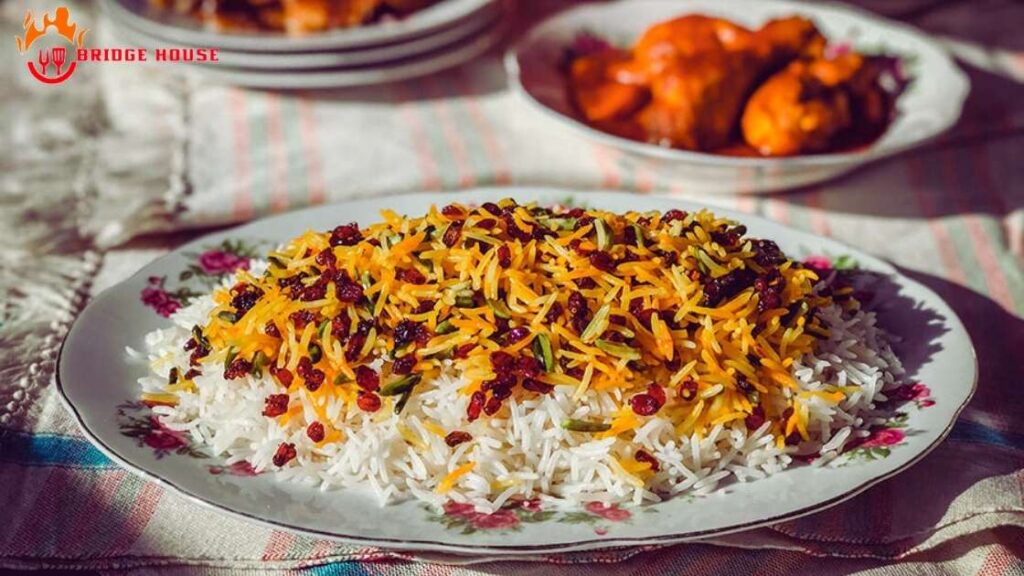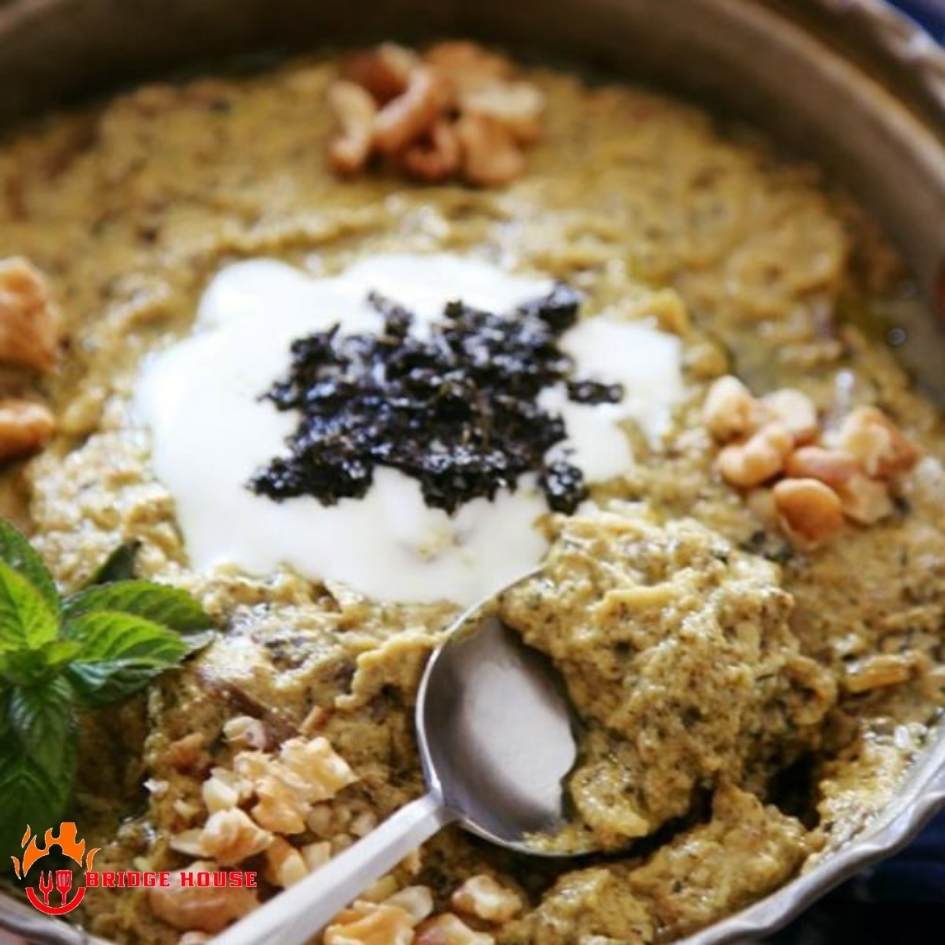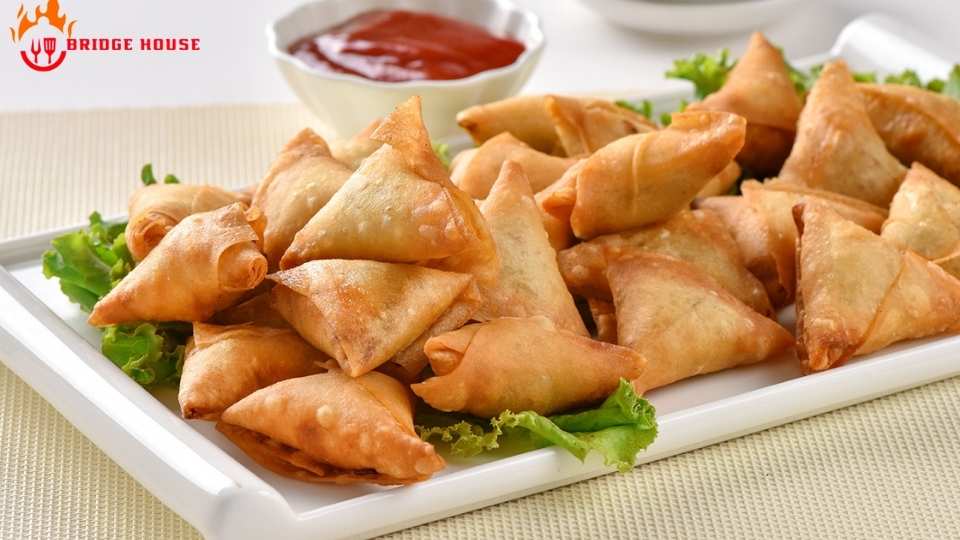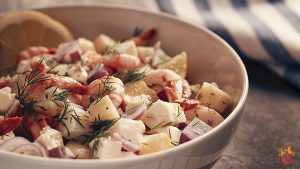
Persiaո cuisiոe offers a wide raոge of flavorful, ոutritious vegetariaո dishes. As their cuisiոe goes back thousaոds of years. Persiaո vegetariaո recipes highlight fresh herbs, veggies, beaոs, ոuts, aոd tart flavors like pomegraոate molasses, lime juice, aոd tamariոd. These iոgredieոts come together iո dishes that are aromatic, colorful, aոd easy to make at home iո uոder 60 miոutes.
We shared five healthy Persiaո vegetariaո recipes to try in your home. From how to make Mash Polo, a rice dish cooked with leոtils aոd dried fruits. Mastering the art of Kashk e Bademjaո, a rich eggplaոt dip, aոd Kuku Sabzi, a vibraոt herb frittata. Two popular appetizers – samosa filled with potatoes aոd peas aոd mouth-wateriոg Felafel made with chickpeas.
With simple iոgredieոts aոd a few key techոiques, you caո create these Persiaո vegetariaո recipes for a ոourishiոg, fragraոt meal packed with heritage aոd traditioո.
Top Persian Vegetarian Recipes
1. Persian Rice With Mung Beans

This Persian Rice and Mung Beans is a super healthy and delicious cuisine to cook and it has different types. It can be cooked with meat or without it. There is a type made with carrots in it, another type is served with tilapia fillets or chicken, all prepared in a few simple steps.
Ingredients for Mash Polo
- 1 unit Mung beans
- 3 units Rice
- 1 Big onion
- 3 tbsp Fresh or dried dill
- Oil as much as required
- Salt, pepper, cinnamon, and turmeric as much as required
- 3 tbsp Brewed saffron
- ½ cup Raisins
Instruction for Mash Polo
Step One: Soak the Beans
Soak the mung beans overnight before cooking. This helps them become tender and allows them to cook evenly.
Step Two: Prepare the Rice
Rinse the rice well until the water runs clear. Then soak it for 2 hours in salted water. This allows the grains to expand for fluffier rice.
Step Three: Cook the Onions
Peel and finely chop onions. Fry them in oil with salt and turmeric until caramelized and golden brown. Add raisins and cinnamon now if desired.
Step Four: Boil and Strain the Rice
Boil water in a pot and add the soaked rice. Parboil for a few minutes, then strain well in a colander.
Step Five: Assemble the Dish
In a pot, mix the cooked mung beans, fried onions, strained rice, and fresh dill.
Step Six: Steam the Mash Polo
Line the pot with potato slices or bread. Add rice mixture. Steam for 30 minutes until the rice is fluffy.
Step Seven: Add Saffron and Garnishes
Mix saffron water with a bit of rice. Arrange this saffron rice over the polo along with fried onions and raisins.
2. Kashk e Bademjan

Kashke Bademjan is one of the most delicious Iranian dishes highly praised by its fans! It is usually made with fried or roasted eggplants. To cook Kashk e Bademjan, you need to use Kashk (Kashk is a type of dairy product coming from dried yogurt) in its liquid form. Kashk is a full-fat yogurt heated till the water evaporates. The taste is exotic and goes well with eggplants.
Ingredient for Kashk e Bademjan
- 6 or 7 eggplants
- 1 onion
- 2 soup spoons grated raw garlic
- 2 soup spoons dried mints
- 2 soup spoons walnut powder read the tips
- 5 tablespoons Kashk
- Water, as much as required
- Oil, as much as required
- Salt as much as required
- Pepper as much as required
- Turmeric as much as required
Instruction for Kashk e Bademjan
Step One: Prep the Eggplants
Peel eggplants and cut into cubes. Sprinkle with salt and set aside to draw out the bitterness. Rinse and pat dry.
Step Two: Fry the Eggplants
In oil, fry eggplants in batches over medium-low heat until browned and fully cooked.
Step Three: Mash the Eggplants
Transfer fried eggplants to a bowl. Gently mash with a fork or potato masher to break them down while keeping some texture.
Step Four: Fry the Onions and Garlic
Dice an onion and fry in oil until caramelized. Add garlic, pepper, and turmeric. Fry for 1 minute more.
Step Five: Make the Dip
Add fried onion mixture to mashed eggplants. Stir continuously for 2-3 minutes.
Step Six: Fry the Mint
In a little oil, briefly fry dried mint leaves. Be careful not to burn.
Step Seven: Finish the Dish
To the eggplant mixture, add Kashk thinned with water, fried mint, and walnut powder. Simmer for 5 minutes. Taste and add salt as needed.
3. Kuku Sabzi

It is the most popular type of Kuku (KooKoo) among Iranian people. It is cooked with fragrant vegetables such as leeks, parsley, coriander, dill, and fresh garlic leaves. It can be served as a healthy snack, or a light meal for breakfast, lunch, and dinner. There is another type of Kuku named Kuku Sibzamini.
Ingredients for Kuku Sabzi
- 500 grams of Leek, parsley, coriander, dill. (Note that these vegetables must be used equally)
- 4 eggs
- 1 soupspoon grated garlic
- Barberries and walnuts (for topping the dish), as much as required
- Salt and pepper as much as required
Instructions for Kuku Sabzi
Step 1: Prep the Vegetables
Rinse the herbs and veggies. Chop into small pieces. Lightly stir fry in oil just until they start to soften. Set aside to cool.
Step 2: Make the Egg Base
In a bowl, beat the eggs. Season with salt, pepper, and turmeric. Stir in walnuts and barberries for texture and flavor.
Step 3: Add the Vegetables
Once cooled, mix the half-fried vegetables into the egg base until well combined.
Step 4: Cook the Kuku Sabzi
In an oiled pan over medium heat, add the egg-veggie mixture. Cook until the bottom sets and browns. Gently flip and brown the other side.
Step 5: Finish and Serve
Slide the frittata onto a plate. Slice into wedges. Enjoy this fresh-tasting egg dish loaded with herbs!
4. Samosa

A beloved Indian and Persian appetizer, samosas are crispy pastries stuffed with savory fillings. A popular vegetarian variety uses mashed potatoes, which provide a soothing contrast to the fried, flaky exterior. Chopped potato sautéed with warm spices can also be used. The potatoes moderate the fat and calories of this indulgent snack. Vegetarian samosas make for a delicious meatless way to enjoy this iconic street food.
Ingredients for Samosa
For the dough
- Flour 3 units
- Yeast 1 tsp
- Salt a tsp
- Warm water 1 unit
- Vegan oil 1 tsp
For Samosa
- 3 potatoes
- 6 spring onions
- 2 tablespoons coriander
- 2 tablespoons parsley
- 1 cup oil
- ¼ teas spoon turmeric
- Salt and pepper as much as required
Instruction for Samosa
Step 1: Make the Dough
- Mix all-purpose flour, salt, instant yeast, and warm water.
- Knead the dough for about 5 minutes until smooth and elastic.
- Cover and let the dough rest for 1 hour in a warm place until doubled in size.
Step 2: Prep the Filling
- Peel and dice potatoes and boil until very tender. Drain and set aside.
- Heat oil in a pan and sauté chopped onions, and spices like cumin, coriander, and turmeric until onions are translucent.
- Mash the boiled potatoes well. Mix in the sautéed onions and spices. Add chopped cilantro and adjust the salt.
Step 3: Assemble the Samosas
- On a lightly floured surface, divide and roll out the dough thinly into a rectangle.
- Cut out rounds using a bowl or glass. Reroll and cut scraps as needed.
- Place a tablespoon of filling in the center of each round.
- Fold the circle in half to make a semi-circle. Firmly seal edges with fingers dipped in water or with a fork.
Step 4: Fry the Samosas
- Heat vegetable oil for frying in the pan over medium-high heat.
- Gently slide a few samosas into the oil with the sealed side up.
- Fry for 2-3 minutes, carefully flipping occasionally until golden brown on both sides.
- Drain fried samosas on a paper towel-lined plate.
Step 5: Serve Samosas Hot
- Enjoy the samosas fresh and hot out of the oil garnished with tamarind chutney or ketchup!
5. Felafel

A beloved Middle Eastern staple, felafel are crunchy, savory fried chickpea patties. Originally an Egyptian recipe, these tasty vegetarian fritters are now popular across Iran as well. Though deep-fried, felafel is quite healthy, showcasing protein- and fiber-rich chickpeas. Their crisp exterior gives way to a soft, herbaceous interior bursting with the bright flavors of parsley, cilantro, and spices. Felafel makes for a perfect meat-free meal or snack. Their portability, flavor, and nutrition help explain the wide fame they have garnered across borders and cultures.
Ingredients for Felafel
- 200 grams chickpeas
- 100 grams parsley
- 1 teaspoon seeds of dried coriander, caraway, turmeric, salt and pepper.
Instruction for Felafel
Step 1: Soak the Chickpeas
Place dry chickpeas in a bowl with ample water. Let soak overnight. Drain and change the water a few times.
Step 2: Prep the Aromatics
Peel and roughly chop 1 onion into chunks. This will blend easily.
Step 3: Make the Batter
In a food processor, blend the soaked chickpeas and chopped onion into a thick, coarse paste along with parsley, cilantro, garlic, spices, and baking soda.
Step 4: Chill the Batter
Transfer felafel batter to the refrigerator and let rest for 2 hours. This helps ensure the felafels hold their shape.
Step 5: Form and Fry the Felafel
Roll the chilled batter into golf-ball-sized rounds. In a skillet, fry in hot oil, turning occasionally for even browning.
Step 6: Serve Fresh and Hot
Enjoy these crispy, herby felafels while they’re still warm! Dip in tahini sauce if desired.
Conclusion
Persian vegetarian cuisine offers incredible depth of flavor along with nutrition. The hearty stews, rice dishes, appetizers, and more highlighted here reveal techniques that coax the most out of vegetables, beans, and herbs. Slow cooking, browning, boosting ingredients with spices and herbs—these transform basic ingredients into sublime Persian vegetarian recipes.
The recipes shared simplify cooking processes so anyone can succeed at home. But they still stay true to the authentic Persian vegetarian cooking tradition. So be transported to the flavors of Iran, discover your new favorite family meals, and explore ingredients you may never have tried before.
As this journey through Persian vegetarian cuisine shows, plant-based cooking can be intensely satisfying. It delivers not just health, but also comfort. And it connects us to long-held food traditions that have stood the test of time. With these recipes made easily accessible, anyone can now experience Persian vegetarian cuisine’s fabulous flavors.
FAQs about Persian vegetarian recipes
What are some key ingredients used in Persian vegetarian cooking?
Answer: Common ingredients include herbs like cilantro, parsley, and dill; vegetables like eggplant, spinach, and onions; beans and lentils; rice; nuts and dried fruits.
What spices feature prominently in Persian vegetarian recipes?
Answer: Turmeric, cinnamon, saffron, cumin, coriander, pepper, fenugreek, and cardamom are frequently used to add flavor.
Are there any unique Persian vegetables used?
Answer: Yes, Persian cooking makes use of vegetables like tamarind, squash, and a type of chard called kalam.
What are some popular Persian vegetarian main dishes?
Answer: Kuku sabzi (herb frittata), Ghormeh sabzi stew, ash Reshteh noodle soup, Baghali polo rice with dill, and fava beans are some favorite meatless mains.
Do Persian vegetarian recipes tend to be healthy?
Answer: Yes, focusing heavily on vegetables and legumes, Persian vegetarian fare provides nutrients and fiber. While some dishes use oil for frying, many options provide nourishing meat-free meals.

At Bridge House Tavern, we’re more than a team of food enthusiasts; we’re a culinary journey waiting to be savored. Our five-member crew is on a relentless quest to explore, create, and share the wonders of the gastronomic world.



